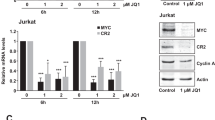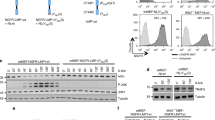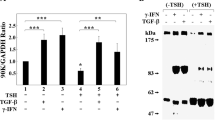Abstract
The expression of the transcriptional activator and tumor suppressor IRF-1 induces multiple effects that counteract the growth of tumor cells in vitro and in vivo. These include the inhibition of cell proliferation, the secretion of interferon-β (IFN-β), the induction of apoptosis specifically in certain cell types and the induction of a strong T-cell response. Here, we show that apart from its immune-activating properties, IRF-1 expression leads to a reversion of the tumorigenic phenotype of NIH3T3 cells transformed by different oncogenes. This was analysed in detail in a cell line in which the expression of c-Ha-ras and c-myc is under the control of a doxycycline-regulated promoter allowing to switch between the normal and oncogenic cell status. In the same cells, a β-estradiol activatable IRF-1 fusion protein is expressed. After IRF-1 activation the oncogene-mediated acceleration of the cell cycle is reverted. Further, a complete IRF-1-mediated reversion of the oncogenic phenotype is observed in soft-agar growth assays. IRF-1 activation induces IFN-β secretion; however, the observed effects are not mediated by IFN-β. Inhibition of tumor growth is observed in nude mice as long as IRF-1 is active, indicating that neither B- nor T-cells must become activated for tumor growth suppression.
This is a preview of subscription content, access via your institution
Access options
Subscribe to this journal
Receive 50 print issues and online access
$259.00 per year
only $5.18 per issue
Buy this article
- Purchase on Springer Link
- Instant access to full article PDF
Prices may be subject to local taxes which are calculated during checkout








Similar content being viewed by others
Abbreviations
- EGFR:
-
epidermal growth factor receptor
- HER:
-
hormone-binding domain of the human estrogen receptor
- ISRE:
-
interferon-stimulated recognition element
- IFN-β:
-
interferon beta
- IRF-1:
-
interferon regulatory factor 1
- STAT:
-
signal transducers and activators of transcription
- GAS:
-
gamma-interferon activated sequence
- E2:
-
β-estradiol
- Dox:
-
doxycycline
- MAB:
-
monoclonal antibody
- w.t.:
-
wild type
References
Andoh A, Fujino S, Bamba S, Araki Y, Okuno T, Bamba T and Fujiyama Y . (2002). J Immunol., 169, 1683–1687.
Baasner S, von Melchner H, Klenner T, Hilgard P and Beckers T . (1996). Oncogene, 13, 901–911.
Baron U, Freundlieb S, Gossen M and Bujard H . (1995). Nucleic Acids Res., 23, 3605–3606.
Benech P, Vigneron M, Perez D, Revel M and Chebath J . (1987). Mol. Cell. Biol., 7, 4498–4504.
Blochlinger K and Diggelmann H . (1984). Mol. Cell. Biol., 4, 2929–2931.
Briken V, Ruffner H, Schultz U, Schwarz A, Reis LF, Strehlow I, Decker T and Staeheli P . (1995). Mol. Cell. Biol., 15, 975–982.
Chin YE, Kitagawa M, Su WC, You ZH, Iwamoto Y and Fu XY . (1996). Science, 272, 719–722.
Chin YE, Kitagawa M, Kuida K, Flavell RA and Fu XY . (1997). Mol. Cell. Biol., 17, 5328–5337.
Colbère-Garapin F, Horodniceanu F, Khourilsky P and Garapin AC . (1981). J. Mol. Biol., 150, 1–13.
Contente S, Kenyon K, Rimoldi D and Friedman RM . (1990). Science, 249, 796–798.
Dinter H and Hauser H . (1987). Eur. J. Biochem., 166, 103–109.
Futaki M, Inokuchi K, Hanawa H, Tanosaki S, Dan K and Nomura T . (1996). Leuk. Res., 20, 601–605.
Gossen M and Bujard H . (1992). Proc. Natl. Acad. Sci. USA, 89, 5547–5551.
Graham F and van der Eb L . (1973). Virology, 52, 456–487.
Gresser I . (1989). Acta Oncol., 28, 347–353
Harada H, Willison K, Sakakibara J, Miyamoto M, Fujita T and Taniguchi, T . (1990). Cell, 63, 303–312.
Harada H, Kitagawa M, Tanaka N, Yamamoto H, Harada K, Ishihara M and Taniguchi T . (1993). Science, 259, 971–974.
Hobart M, Ramassar V, Goes N, Urmson J and Halloran PF . (1996). Transplantation, 62, 1895–1901.
Horiuchi M, Yamada T, Hayashida W and Dzau VJ . (1997). J. Biol. Chem., 272, 11952–11958.
Kamijo R, Harada H, Matsuyama T, Bosland M, Gerecitano J, Shapiro D, Le J, Koh SI, Kimura T, Green SJ, Mak TW, Taniguchi T and Vilcek J . (1994). Science, 263, 1612–1615.
Kenyon K, Contente S, Trackman PC, Tang J, Kagan HM and Friedman RM . (1991). Science, 253, 802.
Kirchhoff S and Hauser H . (1999). Oncogene, 18, 3725–3736
Kirchhoff S, Wiehelm D, Angel P and Hauser H . (1999). Eur. J. Biochem., 2, 546–554.
Kirchhoff S, Schaper F and Hauser H . (1993). Nucleic Acids Res., 21, 2881–2889.
Kirchhoff S, Koester M, Wirth M, Schaper F, Gossen M, Bujard H and Hauser H . (1995a). Trends Genet., 11, 219–220.
Kirchhoff S, Koromilas AE, Schaper F, Grashoff M, Sonenberg N and Hauser H . (1995b). Oncogene, 11, 439–445.
Kröger A, Ortmann D, Krohne TU, Mohr L, Blum HE, Hauser H and Geissler M . (2001). Cancer Res., 61, 2609–2617.
Kröger A, Koster M, Schroeder K, Hauser H and Mueller PP . (2002). J. Interferon Cytokine Res., 22, 5–14.
Kwissa M, Unsinger J, Schirmbeck R, Hauser H and Reimann J . (2000). J. Mol. Med., 78, 495–506.
Lengyel P . (1982). Annu. Rev. Biochem., 51, 251–282.
Matsuyama T, Kimura T, Kitagawa M, Pfeffer K, Kawakami T, Watanabe N, Kundig TM, Amakawa R, Kishihara K and Wakeham AC . (1993). Cell, 75, 83–97.
Nguyen H, Lin R and Hiscott J . (1997). Oncogene, 15, 1425–1435.
Ogasawara K, Hida S, Azimi N, Tagaya Y, Sato T, Yokochi-Fukuda T, Waldmann TA, Taniguchi T and Taki S . (1998). Nature, 391, 700–703.
Ohteki T, Yoshida H, Matsuyama T, Duncan GS, Mak TW and Ohashi PS . (1998). J. Exp. Med., 187, 967–972.
Park JS, Kim EJ, Kwon HJ, Hwang ES, Narmkoong SE and Um SJ . (2000). J. Biol. Chem., 275, 6764–6769.
Qin XQ, Beckham C, Brown JL, Lukashev M and Barsoum, J . (2001). Mol. Ther., 4, 356–364.
Salkowski CA, Barber SA, Detore GR and Vogel SN . (1996). J. Immunol., 156, 3107–3110.
Sambrook J, Fritsch EF and Maniatis T . (1989). Molecular Cloning: A Laboratory Manual, Cold Spring Harbor Laboratory, Cold Spring Harbor: New York.
Stark GR, Kerr IM, Williams BRG, Silverman RH and Schreiber RD . (1998). Annu. Rev. Biochem., 67, 227–264.
Takikawa OT, Kuroiwa T, Yamazaki F and Kido R . (1988). J. Biol. Chem., 263, 2041–2048.
Tamura T, Ishihara M, Lamphier MS, Tanaka N, Oishi I, Aizawa S, Matsuyama T, Mak TW, Taki S and Taniguchi T . (1995). Nature, 376, 596–599.
Tamura T, Ishihara M, Lamphier MS, Tanaka N, Oishi I, Aizawa S, Matsuyama T, Mak TW, Taki S and Taniguchi T . (1997a). Leukemia, 11, 439–440.
Tamura T, Ishihara M, Lamphier MS, Tanaka N, Oishi I, Aizawa S, Matsuyama T, Mak TW, Taki S and Taniguchi T . (1997b). Leukemia, 11, 439–440.
Tan RS, Taniguchi T and Harada H . (1996). Cancer Res., 56, 2417–2421.
Tanaka H and Samuel CE . (1994). Proc. Natl. Acad. Sci. USA, 91, 7995–7999.
Tanaka N, Ishihara M and Taniguchi T . (1994a). Cancer Lett., 83, 191–196.
Tanaka N, Ishihara M, Kitagawa M, Harada H, Kimura T, Matsuyama T, Lamphier MC, Aizawa S, Mak TW and Taniguchi T . (1994b). Cell, 77, 829–839
Tanaka N, Ishihara M, Lamphier MS, Nozawa H, Matsuyama T, Mak TW, Aizawa S, Tokino T, Oren M and Taniguchi T . (1996). Nature, 382, 816–818.
Taniguchi T, Lamphier MS and Tanaka N . (1997). Biochim. Biophys. Acta, 1333, M9–M17.
Unsinger J, Kroger A, Hauser H and Wirth D . (2001). Mol. Ther., 4, 484–489.
Yim JH, Wu SJ, Casey MJ, Norton JA and Doherty GM . (1997). J. Immunol., 158, 1284–1292.
Acknowledgements
We thank M Grashoff and M Höxter for excellent technical support. We gratefully acknowledge the gift of anti-interferon β antibodies by R Zawatzky, Heidelberg. This work has been supported by DFG through SFB 566 (project B7).
Author information
Authors and Affiliations
Corresponding author
Rights and permissions
About this article
Cite this article
Kröger, A., Dallügge, A., Kirchhoff, S. et al. IRF-1 reverts the transformed phenotype of oncogenically transformed cells in vitro and in vivo. Oncogene 22, 1045–1056 (2003). https://doi.org/10.1038/sj.onc.1206260
Received:
Revised:
Accepted:
Published:
Issue Date:
DOI: https://doi.org/10.1038/sj.onc.1206260
Keywords
This article is cited by
-
Interferon regulatory factor 1 (IRF-1) downregulates Checkpoint kinase 1 (CHK1) through miR-195 to upregulate apoptosis and PD-L1 expression in Hepatocellular carcinoma (HCC) cells
British Journal of Cancer (2021)
-
MTMR2 promotes invasion and metastasis of gastric cancer via inactivating IFNγ/STAT1 signaling
Journal of Experimental & Clinical Cancer Research (2019)
-
Anti-apoptotic effect by the suppression of IRF1 as a downstream of Wnt/β-catenin signaling in colorectal cancer cells
Oncogene (2019)
-
Microarray profiling reveals suppressed interferon stimulated gene program in fibroblasts from scleroderma-associated interstitial lung disease
Respiratory Research (2013)
-
Combined gene expression and proteomic analysis of EGF induced apoptosis in A431 cells suggests multiple pathways trigger apoptosis
Apoptosis (2013)



